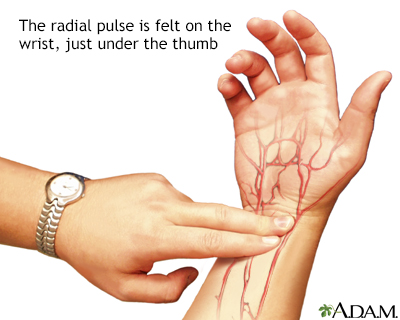Pulse
The pulse is the number of heartbeats per minute.
How the Test is Performed
The pulse can be measured at areas where an artery passes close to the skin. These areas include the:
- Back of the knees
- Groin
- Neck
- Temple
- Top or inner side of the foot
- Wrist
To measure the pulse at your wrist, place your index and middle finger over the underside of your opposite wrist, below the base of the thumb. Press with flat fingers until you feel the pulse.
To measure the pulse on the neck, place the index and middle fingers just to the side of the Adam's apple, in the soft, hollow area. Press gently until you locate the pulse.
Note: Sit or lie down before taking the neck pulse. The neck arteries in some people are sensitive to pressure. Fainting or slowing of the heartbeat can result. Also, do not take the pulses on both sides of the neck at the same time. Doing so can slow the flow of blood to the head and lead to fainting.
Once you find the pulse, count the beats for 1 full minute. Or, count the beats for 30 seconds and multiply by 2. This will give the beats per minute. It is usually accurate to count the beats for shorter times such as 10 or 15 seconds and then multiply by 6 or 4 respectively. It is usually accurate to count the beats for shorter times, such as 10 or 15 seconds, and then multiply by 6 or 4 respectively.
How to Prepare for the Test
To determine the resting heart rate, you must have been resting for at least 10 minutes. Take the exercise heart rate while you are exercising.
How the Test will Feel
There is a slight pressure from the fingers.
Why the Test is Performed
Measuring the pulse gives important information about your health. Any change from your normal heart rate can indicate a health problem. A fast pulse may signal an infection or dehydration. In emergency situations, the pulse rate can help determine if the person's heart is pumping.
Dehydration
Dehydration occurs when your body does not have as much water and fluids as it needs. Dehydration can be mild, moderate, or severe, based on how much...

Pulse measurement has other uses as well. During or immediately after exercise, the pulse rate gives information about your fitness level and health.
Normal Results
For resting heart rate:
- Newborns 0 to 1 month old: 70 to 190 beats per minute
- Infants 1 to 11 months old: 80 to 160 beats per minute
- Children 1 to 2 years old: 80 to 130 beats per minute
- Children 3 to 4 years old: 80 to 120 beats per minute
- Children 5 to 6 years old: 75 to 115 beats per minute
- Children 7 to 9 years old: 70 to 110 beats per minute
- Children 10 years and older, and adults (including seniors): 60 to 100 beats per minute
- Well-trained athletes: 40 to 60 beats per minute
What Abnormal Results Mean
Resting heart rates that are continually high (tachycardia) may mean a problem. Talk to your health care provider about this. Also discuss resting heart rates that are below the normal values (bradycardia).
Tachycardia
An arrhythmia is a disorder of the heart rate (pulse) or heart rhythm. The heart can beat too fast (tachycardia), too slow (bradycardia), or irregul...

Bradycardia
An arrhythmia is a disorder of the heart rate (pulse) or heart rhythm. The heart can beat too fast (tachycardia), too slow (bradycardia), or irregul...

A pulse that is very firm (bounding pulse) and that lasts for more than a few minutes should be checked by your provider as well. An irregular pulse can also indicate a problem.
Bounding pulse
A bounding pulse is a strong throbbing felt over one of the arteries in the body. It is due to a forceful heartbeat.

Irregular pulse
Palpitations are feelings or sensations that your heart is pounding or racing. They can be felt in your chest, throat, or neck. You may:Have an unpl...

A pulse that is hard to locate may mean blockages in the artery. These blockages are common in people with diabetes or hardening of the artery from high cholesterol. Your provider may order a test known as a Doppler study to check the blockages.
Blockages in the artery
Carotid artery disease causes the carotid arteries to become narrowed or blocked. The carotid arteries provide part of the main blood supply to your ...

Hardening of the artery from high chole...
Atherosclerosis, sometimes called "hardening of the arteries," occurs when fat, cholesterol, and other substances build up in the walls of arteries. ...

Doppler study
A duplex ultrasound is a test to see how blood moves through your arteries and veins.

Reviewed By
Linda J. Vorvick, MD, Clinical Professor Emeritus, Department of Family Medicine, UW Medicine, School of Medicine, University of Washington, Seattle, WA. Also reviewed by David C. Dugdale, MD, Medical Director, Brenda Conaway, Editorial Director, and the A.D.A.M. Editorial team.
Bernstein D. History and physical examination in cardiac evaluation. In: Kliegman RM, St. Geme JW, Blum NJ, et al, eds. Nelson Textbook of Pediatrics. 22nd ed. Philadelphia, PA: Elsevier; 2025:chap 471.
Schriger DL. Approach to the patient with abnormal vital signs. In: Goldman L, Cooney KA, eds. Goldman-Cecil Medicine. 27th ed. Philadelphia, PA: Elsevier; 2024:chap 7.




 All rights reserved.
All rights reserved.